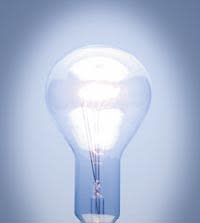|
Q&A Ask the Labs By Joseph L. Bruneni Q.
Prism in Bifocal Segments I had a lab make up a pair of true-cemented Ben Franklin bifocals in the past. Due to safety concerns this is no longer available. Any other options? -Dr. Richard Smart A. You send an interesting question. You may not remember but years ago there was a Flat Top B and a FT R bifocal available that produced prism in the seg only. Vision-Ease still lists a prism seg bifocal simply called "Prism Segment." The seg is 10mm in height and 22 wide but it is only available in glass. It can produce from 1.00 to 4.00 base in prism for near. There is a clever lab in Minnesota that does primarily specialty work for other labs and who may have an answer in plastic. The name is Epic Labs, 320-656-1473. If they come up with an answer in plastic, would you let me know how it works. We'd like to know about it. Reply: Q.
Identifying PALs -David Jones, Essilor Ltd, (UK) A.
The Optical Laboratories Association (OLA) publishes what they call the Progressive Identifier Chart.
My work involves re-lamping business facilities with new fluorescent tubes. This morning I had my eyes tested and was told I need a new prescription. I am in my mid-40s. I feel that my close contact with fluorescent tubes and other lamp types is doing damage to my eyes, but have been advised it's only my age. Your Website has alerted me to believing my gut feeling is correct and that I should take action now to protect my eyes. Please advise if you know anyone here in New Zealand whom I can contact to speak to on this. -Dennis Shrimpton, New Zealand A. You provide an interesting question. The advice about your age being at least part of the reason for your vision problems is right on target. Your primary concern in working with fluorescent lighting would be in regard to ultraviolet (UV) radiation. It has been determined that the amount of UV in the typical office or workplace is so slight that it is not a serious concern. You work much closer to the UV source (the tubes), so it might be wise to take precautions. The best one is to simply make sure your new lenses completely block the harmful portion of UV. The best lens material for that (but not the only one) is polycarbonate. Most optometrists are skilled and trained in understanding lighting issues, so I would think your local area optometrist could take care of your needs. Another thought: Because you probably work overhead at arm's length distance or closer, you'll want a special pair of glasses for use on the job. You have a very unique working condition that conventional bifocals or progressive addition lenses cannot solve. A good vision specialist will know exactly what to prescribe for your on-the-job glasses. EB Got a question you'd like answered in "Ask the Labs?" Send it now!
|
Article
ASK THE LABS
Prism and bifocal; Flourescent lamps and UV; Identifying PALs
Eyecare Business
February 1, 2001




